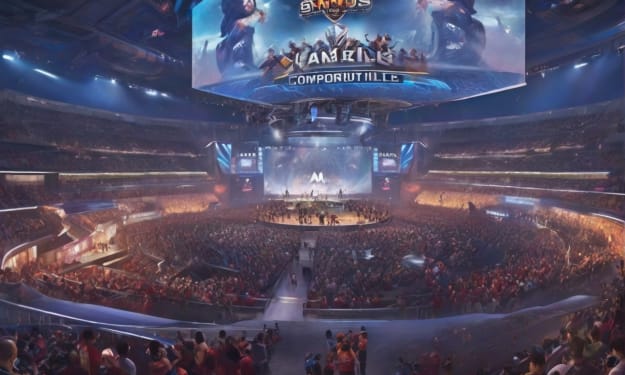The 5 Maddening Monks You Meet During Your Gaming Career
A Meditation on Asinine Acolytes

Monks are, perhaps, one of the most controversial classes in fantasy TTRPGs. Ignoring all of the arguments about theme and genre, though, the monk class has also picked up its share of frustrating character archetypes that can taint this choice in the minds of many players who've had to share a table with them.
If you've managed to avoid these types of monk so far, count yourself lucky. And if you haven't... well, share a story about your experience in the comments!
Also, don't forget to check out the other entries in this series so far! Previous entries include:
For more game content you should also check out my gaming blog Improved Initiative, as well as my Vocal archive!
#1: The Pacifist

Now, before we get too far into things, playing pacifist characters can totally work in TTRPGs. However, as I said in 5 Tips For Playing a Better Pacifist, these characters still need to actually participate in the game in a meaningful way, otherwise they're just increasing the CR of all your encounters, but they're not actually helping you defeat those encounters. This is why you often see pacifist characters choosing cleric, wizard, or even bard, because these classes offer non-combat options that still make them very useful, and they have in-combat options they can take that don't deal damage, but which might still remove an enemy from the board.
The main draw of a monk, though, is that they are unarmed combatants. There are other things you can do, certainly, but this is a major focus of a monk's class features.
The difference between a monk who is a pacifist and a Pacifist Monk (TM), though, is that the player often complains about the very pacifism they opted to have the character follow, and how it restricts their options. Sometimes the choice is a mechanical one (particularly in games where a Vow of Pacifism can grant mechanical bonuses), and sometimes it's a story conceit (the monk's order teaches pacifism as a philosophical good), but if you're going to opt for a character who believes in teachings of non-violence, make sure that the campaign isn't going to require violence on the regular.
#2: The Fearsome Fist

As I said in the section above, the main pull of a monk for a lot of players is they are the unarmed combatants. However, many players simply stop there, treating the monk the same way they would a fighter or a barbarian, and not reading through any of the rest of the class's features beyond flurry of blows, and their Wisdom bonus to armor class.
And if you're just playing a low-level campaign, then the Fearsome Fist is going to handle things just fine. In fact, they may even be a stand out character in terms of effectiveness in the field... but that's going to change in the mid-level to late game if you're part of a long-running campaign.
The Fearsome Fist is the sort of monk who doesn't think beyond an ability to punch or kick an enemy, often to the point where they don't even know the capabilities of their own class. Given that monks have a lot of moving parts, these characters quickly lose steam, and they can feel like they've fallen behind the rest of the party simply because the player hasn't read the instruction manual, and doesn't utilize all the options they have available when it comes to ki powers, feats, archetypes, and so on.
#3: The Reluctant Monk

Reluctant characters are not exclusive to a particular class or player species. With that said, this tendency crops up more often in monks than in almost any other class in my experience, and it can be frustrating when you're all trying to follow the plot, and it feels like the monk is constantly checking their watch to get back home again.
The Reluctant Monk is defined by both their in-character desire not to be on the quest (which can be made into a plot point), but also by the need to cajole the character to get involved with anything the party is doing. If there is a temple in or near the current location, they go there and don't come out unless forced to. If there is no such place, the monk will seek out an isolated spot, and meditate there unless the party finds them, and convinces them to come along for the current arc.
Reluctant Monks are often based on the idea that a monk should remain at a monastery, living a simple life, and adhering to routine. Unfortunately, this means that these characters are often fighting against the plot, and against being involved, which can sometimes lead to the party deciding it's not worth the time and energy to pull them out of their latest bout of navel gazing when they need to go and take care of the problem atop the Smoldering Mountain.
#4: The Incomplete Monk

Incomplete Monks usually have names and physical descriptions, and sometimes they have some broad, general backstories. But beyond that, these characters are relatively blank. What are their goals? To be a monk. What do they like? Doing monk things. What is their profession? Monk. What hobbies do they have, what is their favorite food, or any of a dozen other questions... the answer is monk.
Incomplete characters are not unique to the monk class either. In fact you tend to see them a lot with clerics and paladins, as well. In all cases, though, the idea of the character's class subsuming who they are as a person is usually responsible for this kind of character. The player isn't playing Jehiro, a bandit who was taken in by a monastery who has been trying to better himself and walk a narrower path... they're playing Jehiro the monk, and not much else.
Take a moment to really think about who your character is, and how their teachings and philosophies shape them. But, at the same time, remember that you should be more than just a pile of wise-sounding proverbs inside a set of rippling abs.
#5: A Dead End Build

Again, monks are not the only class to experience the Dead End Build, but it is something I see more commonly among monks than fighters, barbarians, and many other classes. This is particularly true for monks that focus on combat maneuvers (disarming, grappling, tripping, etc.,) simply because these techniques often have an effective ceiling, past which they simply are no longer going to work.
This can be an early level trap, particularly in games like Pathfinder's first edition, where monks could rapidly acquire the feats to master disarming opponents, tripping them to the ground, or grappling them, which are very useful for those who want to make a pacifist-style character who can end a fight without truly harming anyone. However, campaigns where you end up fighting a lot of beasts, devils, or other creatures that are quadrupeds, have natural weapons, or which can actively harm you if you grapple them, can put a serious damper on what this character was built to do. And when we escalate that to enemies who are always flying, who have freedom of movement, or who are so colossal that it would be all but impossible to succeed with a maneuver like this, this kind of monk can quickly feel like they're being sidelined through no fault of their own.
As a final note, this type of character is listed last, because a GM can still provide opportunities for their skill sets to work. Whether it's including multiple monsters in encounters so the monk has a dance partner, or purposefully not using elements that completely negate a monk's build, this can be a good way to keep the character included. However, if you're thinking of trying to make a monk who is extremely focused on a very narrow skill set, check with the GM first to be sure that skill set is going to be useful all the way through your current campaign.
Additional Monk Articles
If you haven't had enough monk-centric content yet, make sure you check out the following:
- 5 Tips For Playing Better Monks
- 5 Unusual Martial Arts For Your Monks
- The Non-Problem of Making Monks Fit Your Setting
Like, Follow, and Stay in Touch!
That's all for this week's Fluff post!
For more of my work, check out my Vocal archive, and stop by the YouTube channel Azukail Games, where I share a lot of video content. Or if you'd prefer to read some of my books, like my sword and sorcery novel Crier's Knife, my sci fi dystopia thriller Old Soldiers, or my recent short story collection The Rejects, then head over to My Amazon Author Page!
To stay on top of all my latest releases, follow me on Facebook, Twitter, and now Pinterest as well! To support my work, consider Buying Me a Ko-Fi, or heading over to The Literary Mercenary's Patreon page to become a regular, monthly patron. That one helps ensure you get more content, and it means you'll get my regular, monthly giveaways as a bonus!
About the Creator
Neal Litherland
Neal Litherland is an author, freelance blogger, and RPG designer. A regular on the Chicago convention circuit, he works in a variety of genres.
Blog: Improved Initiative and The Literary Mercenary






Comments (1)
Good article as usual, though I admit I haven't met too many of your frustrating monks; only the unprepared and the pacifist types. Those are all too common and as you pointed out the unprepared character seems to crop up in every class.